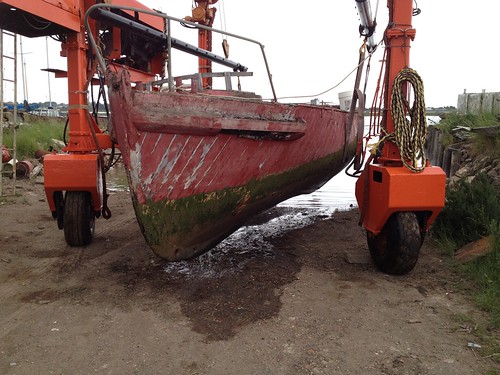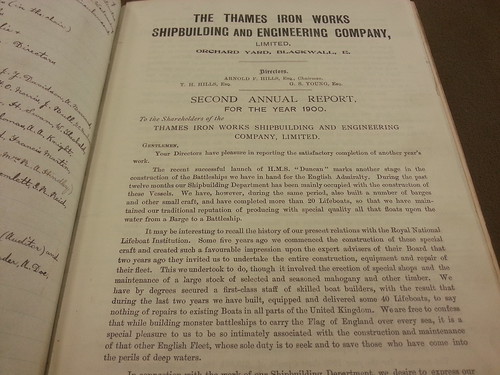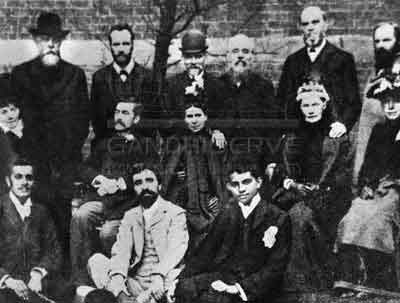gavros
New member
It is now more than likely that West Ham United FC will move to the Olympic Stadium in Stratford in 2016. Many fans of the club are concerned that the move would mean a loss of heritage; after all, West Ham has been at its current home, Upton Park, for well over 100 years now. However, as hinted by the crossed hammers in their badge and their nicknames the ‘Hammers’ and the ‘Irons’, the even more distant history of the club lies closer to the stadium than many fans think. It is this distant history that we are aiming to revive, and in doing so, that of the history of east London as a whole.
Put simply, a small group of fans are in the final processes of setting up a charity to restore a number of fully operational Thames Ironworks lifeboats, which will bring back long-lost skills in shipwrigthting to the area, be used to offer educational heritage tours of the waterways around the Queen Elizabeth Olympic Park and wider canal and river network, provide work and training in boatmastery for young local people and tour guide skills to older people with first hand memories of the areas industrial past, and eventually generate a surplus that can be re-invested back into charitable causes on the rivers.
The history
The Thames Ironworks and Shipbuilding and Engineering Company Ltd was incorporated in 1857, taking over the operations of C.J Mare and Co. The company’s expertise in the production of iron ships stood it in good stead as the ironclad era of warship production came into being. Starting with orders from the British Admiralty, the Ironworks went onto build warships for the Italian, Japanese, Turkish, Romanian and Peruvian navies amongst others.
Increasing competition from the lower cost northern yards, and the rise of foreign shipyards, made life increasingly had for the Ironworks after the turn of the 20th century. As a result an increasingly important part of the company’s revenues came from the production of lifeboats. The Ironworks produced over 250 of these for eventual use with the RNLI, helping to keep the company’s head above water until it eventually folded in 1912 – just a couple of years short of the militarisation that took place ahead of the Great War that would have saved the yard.

Lifeboats under construction at the Thames Ironworks, and lifeboat ‘William’ in finished state in the factory
The surviving boats
Not much is left of the hundreds of ships produced by the Ironworks. Perhaps 30 boats exist in the world, the most important of which is HMS Warrior, permanently moored at Portsmouth. A handful of the lifeboats remain, some of which have been restored, with one or two seaworthy examples still around. There are a few wrecks still out there, though. One such until recently was the Helen Smitton, made in 1910, and the first lifeboat in St Abbs, Berwickshire. She was found (literally) at the back of a barn by a professional restorer, who has now gone some way to restoring her to as near-perfect condition as is possible.


The Helen Smitton, at the back of a barn, and on the way to full restoration
Others remain totally decrepit. We found the Janet Hoyle, made in 1908, on a mudflat in Essex. The owner sold her to us for £1, and we’re very pleased to say that a conservation specialist has assured us that it is restorable, thanks to the quality of materials used – mainly Honduran mahogany – and the high level of workmanship involved, which has allowed the boat to survive over a hundred years of punishment. We have heard of two or three boats in a similar condition.

The Janet Hoyle, a 35’ Liverpool class lifeboat made by the Thames Ironworks in 1908
Along with the story of these boats are some wonderful human stories that we are developing. We, know, for example, that the Helen Smitton was paid for out of the will of Mr James Hodge, of Manchester, in 1907. His request was that the lifeboat for the RNLI be based on the east coast of Scotland, his and his wife's place of birth, and named Helen Smitton, following his late wife's maiden name. Another boat that we are close to securing is being gifted to the Trust by its owner of 45 years, who has now become too frail to look after her, and who wants future generations to enjoy the boat as much as he and his wife have done. This is something that we will, naturally, be committed to.
The plan
Saving these boats is, we think, worthy in its own right, but the plan is more ambitious than that. The move to the Olympic Stadium will reconnect West Ham with the waterways on which it was born as Thames Ironworks FC. The Olympic Park itself is a maze of waterways based on the river Lea, first cut by Alfred the Great in 896 to drain the river and beach the Vikings upstream, and altered continuously from then up until 1930. Their greatest use was seen during the Industrial Revolution due to the need for maritime transportation. The plan, then, is to find a spot close to the original factory, re-establishing the Thames Ironworks (well, a boat shed, but you get the gist). We would employ a master and apprentices to conduct the restoration, bringing back skills in shipwrighting that have been lost to east London for over 100 years.
Once the boats are complete, we aim to use them to offer tours in and around the Olympic Park. The focus on the industrial and pre-industrial heritage; something that is at risk of being lost as the area slowly gentrifies. The service would offer apprenticeships to local people, training them for qualifications such as the blue badge (Guild of Registered Tourist Guides) and boatmasters license, as well as potentially the City and Guilds Level II qualification awarded to the Olympic Games Makers. We would also hope that mature people with experience of working on the river and docks can contribute by giving first hand stories of their time on these waterways. We hope to be able to secure a mooring close to the stadium itself, helping to reconnect the club to its past, two miles downstream at Leamouth. Along with the mooring, we would ideally like to have our own ticket office/ shop/ museum. We have been speaking to Crossrail, who have been working on the original Ironworks site in Canning Town and have recovered lots of material from the site. If possible, then, we hope to build our eventual building from the materials that made up the original Ironworks itself. Discussions with Newham Council and the LLDC are ongoing.

The network of waterways in east London. The Olympic Stadium is marked (1) on this map. The Thames Ironworks were situated on both sides of the river as it entered the Thames at Leamouth
Funding
The initial phase of fundraising will start soon, when charitable status is confirmed and the bank account and HMRC paperwork is complete, which should be done in two to three weeks. In this phase, we will primarily look to raise money from fans and from boating and lifeboat enthusiasts, generating momentum and publicity for the project along the way. As things develop further, we will look to receive help from the Heritage Lottery Fund, as well as West Ham United. The project, we think, makes sense for the club to help to fund, given that it would be a symbolic gesture to fans, many of whom are worried that the move to the Olympic Stadium will result to a loss of heritage. This project would help to counter that, linking the club back to its very earliest days, and reinforcing the point that in many ways, this is a move back home.
We expect the service to be self sufficient after its start up costs – indeed; according to our financial workings, the boats should generate a healthy surplus, which could then be used to invest further (by the addition of restoring further boats for service) or to fund other charitable activities along the river. We are particularly aware of the problems of pollution on the Lea, and would aim to make consistent contributions to help tackle this problem. We will also aim to subsidise the boat shed even after the last of the Thames Ironworks boats are restored, so that, in conjunction with a local college and with maritime experts, we can continue to support the rekindling of the art of boatbuilding in east London.

Helen Smitton being launched at St Abbs, where she helped saved lives after HMS Pathfinder was torpedoed by U-21 in 1914
Progress to date
We have had preliminary discussions with the Heritage Lottery Fund, Canal and River Trust, and, thankfully, have had very strong support from the North & East London branch of the Inland Waterways Association. Local politicians, including Stephen Timms and Lyn Brown, MPs for East Ham and West Ham respectively, have pledged their support, as has John Biggs, who covers the City and East London for the London Assembly. We are now in close contact with Newham Council and hope soon to be able to talk to the LLDC.
Put simply, a small group of fans are in the final processes of setting up a charity to restore a number of fully operational Thames Ironworks lifeboats, which will bring back long-lost skills in shipwrigthting to the area, be used to offer educational heritage tours of the waterways around the Queen Elizabeth Olympic Park and wider canal and river network, provide work and training in boatmastery for young local people and tour guide skills to older people with first hand memories of the areas industrial past, and eventually generate a surplus that can be re-invested back into charitable causes on the rivers.
The history
The Thames Ironworks and Shipbuilding and Engineering Company Ltd was incorporated in 1857, taking over the operations of C.J Mare and Co. The company’s expertise in the production of iron ships stood it in good stead as the ironclad era of warship production came into being. Starting with orders from the British Admiralty, the Ironworks went onto build warships for the Italian, Japanese, Turkish, Romanian and Peruvian navies amongst others.
Increasing competition from the lower cost northern yards, and the rise of foreign shipyards, made life increasingly had for the Ironworks after the turn of the 20th century. As a result an increasingly important part of the company’s revenues came from the production of lifeboats. The Ironworks produced over 250 of these for eventual use with the RNLI, helping to keep the company’s head above water until it eventually folded in 1912 – just a couple of years short of the militarisation that took place ahead of the Great War that would have saved the yard.

Lifeboats under construction at the Thames Ironworks, and lifeboat ‘William’ in finished state in the factory
The surviving boats
Not much is left of the hundreds of ships produced by the Ironworks. Perhaps 30 boats exist in the world, the most important of which is HMS Warrior, permanently moored at Portsmouth. A handful of the lifeboats remain, some of which have been restored, with one or two seaworthy examples still around. There are a few wrecks still out there, though. One such until recently was the Helen Smitton, made in 1910, and the first lifeboat in St Abbs, Berwickshire. She was found (literally) at the back of a barn by a professional restorer, who has now gone some way to restoring her to as near-perfect condition as is possible.


The Helen Smitton, at the back of a barn, and on the way to full restoration
Others remain totally decrepit. We found the Janet Hoyle, made in 1908, on a mudflat in Essex. The owner sold her to us for £1, and we’re very pleased to say that a conservation specialist has assured us that it is restorable, thanks to the quality of materials used – mainly Honduran mahogany – and the high level of workmanship involved, which has allowed the boat to survive over a hundred years of punishment. We have heard of two or three boats in a similar condition.

The Janet Hoyle, a 35’ Liverpool class lifeboat made by the Thames Ironworks in 1908
Along with the story of these boats are some wonderful human stories that we are developing. We, know, for example, that the Helen Smitton was paid for out of the will of Mr James Hodge, of Manchester, in 1907. His request was that the lifeboat for the RNLI be based on the east coast of Scotland, his and his wife's place of birth, and named Helen Smitton, following his late wife's maiden name. Another boat that we are close to securing is being gifted to the Trust by its owner of 45 years, who has now become too frail to look after her, and who wants future generations to enjoy the boat as much as he and his wife have done. This is something that we will, naturally, be committed to.
The plan
Saving these boats is, we think, worthy in its own right, but the plan is more ambitious than that. The move to the Olympic Stadium will reconnect West Ham with the waterways on which it was born as Thames Ironworks FC. The Olympic Park itself is a maze of waterways based on the river Lea, first cut by Alfred the Great in 896 to drain the river and beach the Vikings upstream, and altered continuously from then up until 1930. Their greatest use was seen during the Industrial Revolution due to the need for maritime transportation. The plan, then, is to find a spot close to the original factory, re-establishing the Thames Ironworks (well, a boat shed, but you get the gist). We would employ a master and apprentices to conduct the restoration, bringing back skills in shipwrighting that have been lost to east London for over 100 years.
Once the boats are complete, we aim to use them to offer tours in and around the Olympic Park. The focus on the industrial and pre-industrial heritage; something that is at risk of being lost as the area slowly gentrifies. The service would offer apprenticeships to local people, training them for qualifications such as the blue badge (Guild of Registered Tourist Guides) and boatmasters license, as well as potentially the City and Guilds Level II qualification awarded to the Olympic Games Makers. We would also hope that mature people with experience of working on the river and docks can contribute by giving first hand stories of their time on these waterways. We hope to be able to secure a mooring close to the stadium itself, helping to reconnect the club to its past, two miles downstream at Leamouth. Along with the mooring, we would ideally like to have our own ticket office/ shop/ museum. We have been speaking to Crossrail, who have been working on the original Ironworks site in Canning Town and have recovered lots of material from the site. If possible, then, we hope to build our eventual building from the materials that made up the original Ironworks itself. Discussions with Newham Council and the LLDC are ongoing.
The network of waterways in east London. The Olympic Stadium is marked (1) on this map. The Thames Ironworks were situated on both sides of the river as it entered the Thames at Leamouth
Funding
The initial phase of fundraising will start soon, when charitable status is confirmed and the bank account and HMRC paperwork is complete, which should be done in two to three weeks. In this phase, we will primarily look to raise money from fans and from boating and lifeboat enthusiasts, generating momentum and publicity for the project along the way. As things develop further, we will look to receive help from the Heritage Lottery Fund, as well as West Ham United. The project, we think, makes sense for the club to help to fund, given that it would be a symbolic gesture to fans, many of whom are worried that the move to the Olympic Stadium will result to a loss of heritage. This project would help to counter that, linking the club back to its very earliest days, and reinforcing the point that in many ways, this is a move back home.
We expect the service to be self sufficient after its start up costs – indeed; according to our financial workings, the boats should generate a healthy surplus, which could then be used to invest further (by the addition of restoring further boats for service) or to fund other charitable activities along the river. We are particularly aware of the problems of pollution on the Lea, and would aim to make consistent contributions to help tackle this problem. We will also aim to subsidise the boat shed even after the last of the Thames Ironworks boats are restored, so that, in conjunction with a local college and with maritime experts, we can continue to support the rekindling of the art of boatbuilding in east London.

Helen Smitton being launched at St Abbs, where she helped saved lives after HMS Pathfinder was torpedoed by U-21 in 1914
Progress to date
We have had preliminary discussions with the Heritage Lottery Fund, Canal and River Trust, and, thankfully, have had very strong support from the North & East London branch of the Inland Waterways Association. Local politicians, including Stephen Timms and Lyn Brown, MPs for East Ham and West Ham respectively, have pledged their support, as has John Biggs, who covers the City and East London for the London Assembly. We are now in close contact with Newham Council and hope soon to be able to talk to the LLDC.
Last edited:








